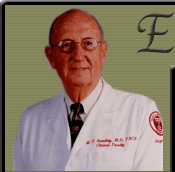|
|

Gallbladder Disease in Children
Cholecystitis, an inflammation of the gallbladder, can be classified as calculous or acalculous. The classification is based on the presence or abscence of gallstones. Chronic cholecystitis with gallstones is the most common occurring in over two thirds of children with this diagnosis. Approximately 40% of all pediatric cases occur in children less than 11 years of age and 60% occur in children 11 to 20 years of age.#1. Acalculous cholecystitis affects younger children more often.
Recurrent attacks of inflammation lead to progressive scarring of the gallbladder wall with loss of function and gallstone formation. Polyp formation may precede cholecystitis.
The acutely inflamed gallbladder may or may not be filled with sludge or gallstones. The temperature and the white blood count may be elevated with pain in the right upper quadrant of the abdomen.
The chronically inflamed gallbladder may be enlarged or contracted, filled with stones and with similar signs and symptoms.
Cholesterolosis of the gallbladder, another form of gallbladder disease, occurs when crystals of cholesterol are deposited in the submucosal macrophages of the gallbladder wall causing its dysfunction.
The incidence of cholecystitis in children appears to be increasing with girls being affected after adolesence more commonly than boys. This may be due to an increase in estrogen levels at puberty in the female. This phenomenon can be easily understood when one considers that the pharmaceutical industry includes in their list of adverse reactions in taking birth control pills the following: gallstones may occur after four years of being on the "pill". These pills interfere with the normal female estrogen-progesterone levels. Both sexes are affected equally before puberty.
A family history of biliary disease, especially in grandparents or aunts, may be identified in children with cholecystitis.
The signs and symptoms of cholecystitis in children are similar to those in adults. Episodic abdominal pain localized to the right upper quadrant and/or epigastrium, radiating to the back at the tip of the scapula (wing bone) is the most common complaint. Vomiting and dietary fat intolerance affect 30-40% of patients, Symptoms may be present as long as ten years before the correct diagnosis of gallbladder dysfunction or cholecystitis is made. The dysfunction may be congenital (present at birth) due to anatomical or vascular abnormalities as well as due to inflammation.
An elevated serum bilirubin and elevated alkaline phosphatase (liver enzymes) may be present, but not necessarily, in many patients.
Abdominal ultrasound is the most effective non-invasive method to detect gallbladder disease. However, ultrasound cannot detect gallstones smaller than 3mm. Therefore, a negative ultrasound is never conclusive. A CCK stimulation test is absolutely necessary to detect gallbladder dysfunction. The test should always be performed with the patient in the erect position. A description of the erect ultrasound CCK Stimulation Test is described on this web site under "Tests".
Cholecystitis should be considered early in the differential diagnosis of abdominal pain especially in high-risk children who have a family history of gallbladder disease.
Laparoscopic cholecystectomy is considered the treatment of choice for the management of uncomplicated acute cholecystitis. It is also considered to be the treatment of choice for chronic cholecystitis, particularly in the cases of symptomatic gallstones.
The possibility of gallbladder disease in a child complaining of abdominal pain associated with eating, fatty food intolerance and having a family history of gallbladder disease should always be thoroughly investigated before a diagnosis of irritable bowel syndrome is made.
#1. Motil, KJ. Cholecystitis. In: McMillan, JA. Editor-in-chief, Oski's Pediatrics: Principles & Practice. 4th ed. Philadelphia: Lippincott Williams & Wilkins; 2006:2042-2045.
Additional Information:
Irritable Bowel Syndrome |
Gallbladder Disease
Gallbladder Disease in Children |
Depression |
Gastroparesis
Insurance & Financial Considerations | Followup Stories
Home
| Parents | Questions
| Therapy | Tests
| Diet | Contact
Mom, do I Look fat?
The FAT BOOK
|
|


